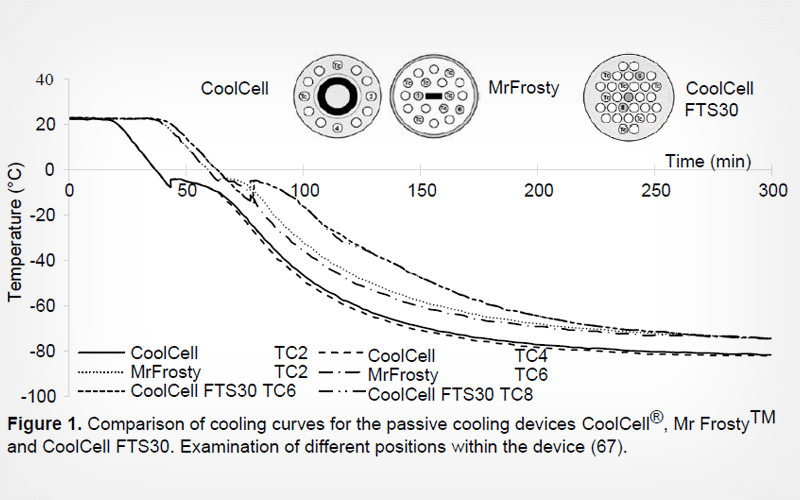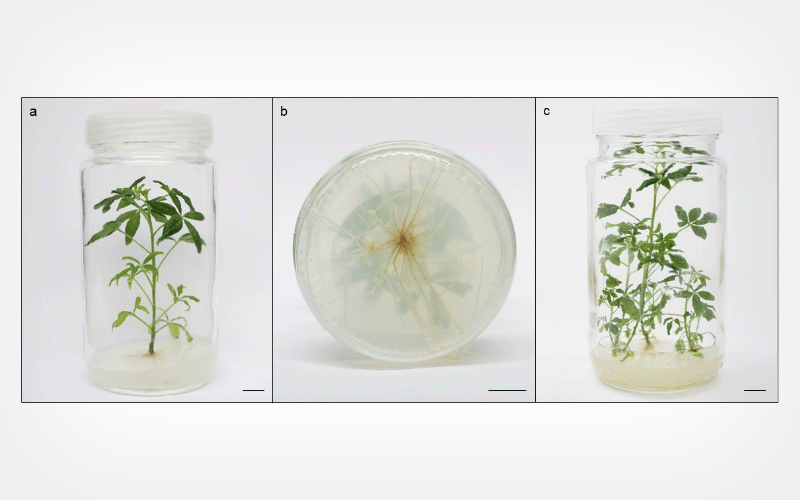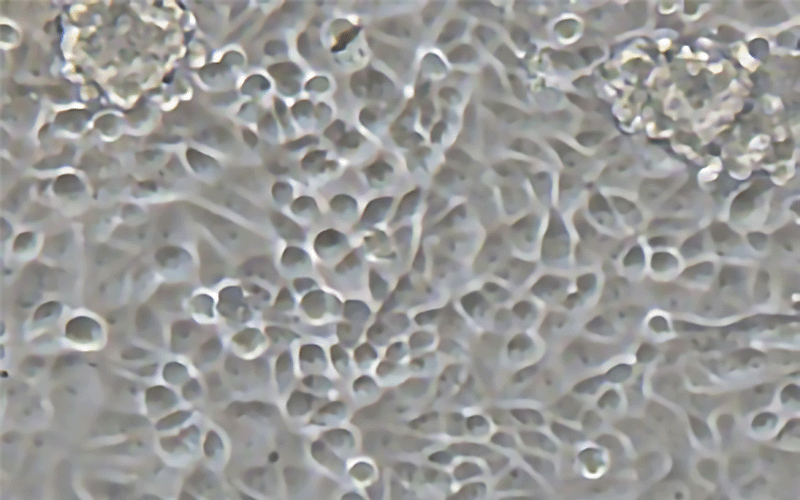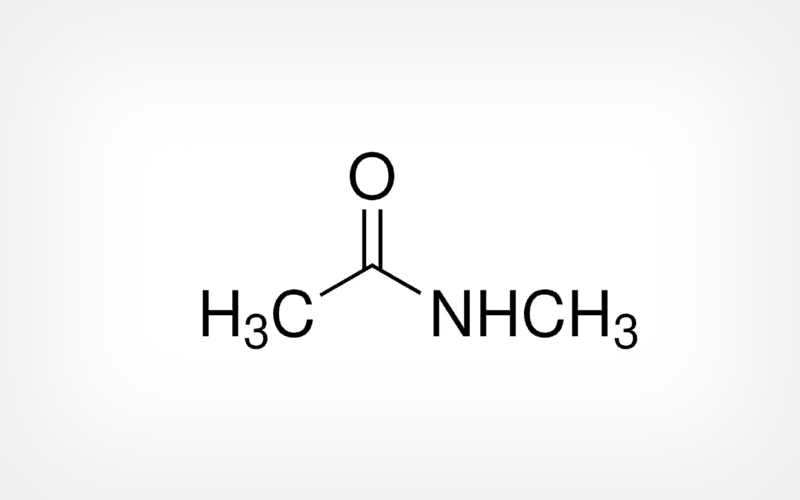CryoLetters Volume 44 - Issue 6
CryoLetters 44(6), 314-326 (2023)
© CryoLetters, editor@cryoletters.org
doi.org/10.54680/fr23610110112
PERSPECTIVE: The technology in cryotechnology
Janina Hagedorn1*, Ghiath Alkurdi1, Sven-Alexander Barker1, Ricarda Brunotte1,Tarek Deeb1, Oleksandra Hubenia1,2, Diaa Khayyat11, Sara Leal-Marin1, Tim Rittinghaus1 and Birgit Glasmacher1
- Institute for Multiphase Processes, Leibniz University Hannover, Garbsen,30823, Germany
- Institute for Problems of Cryobiology and Cryomedicine, National Academy of Sciences of Ukraine, Kharkiv, 61016, Ukraine
*Corresponding author’s E-mail: hagedorn@imp.uni-hannover.de
Abstract
The process of freezing biological material at extremely low temperatures is known as cryopreservation. To ensure the preservation of cells and tissues over an extended period of time, low temperatures are applied since biological processes, including the biochemical ones, come to a halt under cryogenic conditions and thus it is possible to maintain their structural and functional integrity. The field of cryopreservation gained more prominence in the 20th century and emerged as an unavoidable technology for different applications such as cell therapy, tissue engineering, or assisted fertilization. In this work we provide an overview of various technologies in the field of cryotechnology with regard to the freezing, storage and thawing of living cells. The first part covers the freezing process, starting with cryoprotective agents regarding their protection mechanisms and compositions, passing by cryoimaging, micro-fluidic systems, and the currently available freezing and biobanking equipment. The second part focusses on the thawing process as well as the hypothermic preservation for the short-term storage of biological materials and constructs.
Keywords: biobanking; CPA; freezing; hypothermal storage; nanowarming; microfluidic

CryoLetters 44(6), 327-323 (2023)
© CryoLetters, editor@cryoletters.org
doi.org/10.54680/fr23610110312
IGF-1 stabilizes goat sperm mitochondrial transmembrane potential and reduces DNA fragmentation
Ravi Ranjan1*, Kaustubh Sharma1, Manish Kumar1, Dilip Kumar Swain2, Shiva Pratap Singh1, Suresh Dinkar Kharche1, Manoj Kumar Singh1 and Manmohan Singh Chauhan3
- Indian Council of Agricultural Research (ICAR), Central Institute for Research on Goats, Makhdoom, Farah, Mathura, Uttar Pradesh (U.P.), India 281122
- Deen Dayal Upadhyaya Pashu Chikitsa Vigyan Vishwavidyalaya Evam Go-Anusandhan Sansthan (DUVASU), Mathura, U.P. India 281001
- ICAR-National Dairy Research Institute, Karnal, Haryana, India 132001
*Corresponding author’s E-mail: dr_raviranjan@yahoo.co.in
Abstract
Background
Antioxidant present in sperm cells protects them from oxidative damage. However, sperm are more susceptible to peroxidative damages due to the loss of these enzymes during cryopreservation and their survival and fertility may be compromised. Insulin like growth factor-1 (IGF-1) has an antioxidant effect and could maintain sperm motility.
Objective
To improve seminal parameters, mitochondrial membrane potential (MMP), oxidative status and DNA integrity of buck semen after freeze-thawing by fortification of goat semen diluent with various concentrations of IGF-1.
Materials and methods
Fifty ejaculates were collected and were extended with tris- citric acid- fructose diluent with 10% egg yolk and 6% glycerol with sperm concentrations of 1 x 108 mL-1. Post-cryopreserved sperm were assessed for motility and a range of other functional parameters.
Results
In post-thaw semen sperm motility, live sperm count, acrosome integrity, hypo-osmotic swelling positive spermatozoa, malondialdehyde (MDA), protein carbonyl content (PCC), TUNEL positive sperm differed significantly (P<0.05) with the various concentrations of IGF-1 used. Sperm functional parameters post-thawing were significantly (P<0.05) better in 250 ng/mL IGF-1. IGF-1 protects against lipid peroxidation by lowering MDA and PCC production, thus reducing the harmful effect of reactive oxygen species. The kidding percentage using the artificial insemination technique was significantly higher ( i.e., 40%) in the group supplemented with 250 ng/mL of IGF-1 than in the non-supplemented group (i.e., 30%).
Conclusion
GF-1 may be used to improve post-thaw semen quality and fertility as measured by actual kidding rate.
Keywords: artificial insemination; IGF-1; malondialdehyde; MMP; TUNEL assay

CryoLetters 44(6), >333-342 (2023)
© CryoLetters, editor@cryoletters.org
doi.org/10.54680/fr23610110512
Application of D cryo-plate technique for the cryopreservation of in vitro-grown shoot tips of Tarenaya spinosa (Cleomaceae)
Anna Flávia Rodrigues Mortani Vilardo, Gustavo Dias da Silva Lima, Lívia da Silva Cordeiro, Norma Albarello and Claudia Simões-Gurgel
- Laboratório de Biotecnologia de Plantas (LABPLAN), Núcleo de Biotecnologia Vegetal (NBV), Instituto de Biologia Roberto Alcantara Gomes (IBRAG), Universidade do Estado do Rio de Janeiro (UERJ). Rua São Francisco Xavier, 524, PHLC, sala 509, Maracanã, CEP 20550-013 - Rio de Janeiro, RJ, Brazil
*Corresponding author’s E-mail: anna.flavia.vilardo@gmail.com
Abstract
Background
Tarenaya spinosa is a medicinal species used for treating respiratory and inflammatory diseases. Various biotechnological studies have been developed for in vitro establishment of plants and long-term conservation of this species.
Objective
This study aimed to establish a new cryopreservation protocol using the D cryo-plate technique for in vitro-grown shoot tips of T. spinosa.
Materials and methods
Different steps of the cryopreservation procedure were evaluated in this work: preculture; sucrose concentration of calcium alginate gel; concentration and time of exposure to osmoprotective loading solution; time of exposure to silica gel; and regrowth on recovery medium.
Results
The optimal procedure included preculture with increasing sucrose concentration (from 0.25 to 0.50 M), encapsulation and dehydration over silica-gel for 60 min. Increasing sucrose concentration in the loading solution or exposure duration had a negative effect on recovery of cryopreserved shoot tips. However, the association of calcium alginate gel enriched with 0.6 M sucrose with post-rewarming culture with BAP for 2 weeks resulted in the most efficient cryopreservation protocol (76% survival and 70% shoot recovery).
Conclusion
The plants developed after cryopreservation maintained their in vitro multiplication capacity and demonstrated the efficiency of long-term conservation by D cryo-plate technique for T. spinosa.
Keywords: aluminum cryo-plate; dehydration; in vitro conservation; medicinal plant; silica gel

CryoLetters 44(6), 343-351 (2023)
© CryoLetters, editor@cryoletters.org
doi.org/10.54680/fr23610110712
Role of oleic acid and trehalose on frozen-thawed ram semen
Leila Soltani*
- Department of Animal Science, Faculty of Agricultural and Engineering Science, Razi University, Kermanshah, Iran
*Corresponding author’s E-mail: leilasoltani7@yahoo.com
Abstract
Background
When sperm are cryopreserved, reactive oxygen species (ROS) are formed that are detrimental to the sperm.
Objective
To evaluate the effects of oleic acid and trehalose added to ram semen extender on sperm parameters, lipid peroxidation (MDA), and superoxide dismutase (SOD) enzyme levels of spermatozoa following the freeze/thawing processes.
Materials and methods
Ejaculates were collected from four rams and pooled at 35°C. Pooled ejaculates were diluted with oleic acid at 0 mM and trehalose at 0 mM (O0 T0) as the control. The Tris-based extender was supplemented with either 0.5 (O0.5) or 1 (O1) mM of oleic acid or 25 (T25) or 50 (T50) mM of trehalose alone, and in combination [0.5 mM oleic acid + 25 mM trehalose (O0.5T25), 0.5 mM oleic acid + 50 mM trehalose (O0.5T50), 1 mM oleic acid + 25 mM trehalose (O1T25) and 1 mM oleic acid + 50 mM trehalose (O1T50)]. The semen was frozen by the traditional liquid nitrogen vapour method and stored at -196°C in the liquid nitrogen tank.
Results
Semen extender containing O1T25 significantly improved the total motility, when compared with other treatment groups (P<0.05), except for O1T50. O1T50 had a higher viability rate than any other treatment. The addition of O1T25 and O1T50 increased DNA and membrane integrity of spermatozoa post-thawing compared to other treatments (P<0.05). The level of MDA was significantly (P<0.05) lower in extenders supplemented with O1, O0.5T25, O0.5T50, O1T25 and O1T50 compared to the other treatment groups. In addition, SOD levels were higher in groups treated with O1T25 and O1T50 than the other treatment groups (P<0.05).
Conclusion
The addition of a combination of oleic acid and trehalose concentrations to Tris-based extender improved the quality of ram semen post-thawing.
Keywords: freezing; oleic acid; sheep; spermatozoa; trehalose

CryoLetters 44(6), 352-359 (2023)
© CryoLetters, editor@cryoletters.org
doi.org/10.54680/fr23610110212
Effect of dalargin on apoptosis of L929 fibroblasts during cold stress
Nataliia Moisieieva, Olga Gorina* and Yuliia Akhatova
- Institute for Problems of Cryobiology and Cryomedicine of National Academy of Sciences of Ukraine, 23, Pereyaslavska Str., Kharkiv 61016, Ukraine
*Corresponding author’s E-mail: ogorina2603@gmail.com
Abstract
Background
The search for compounds that can prevent cold stress-attributed apoptosis is of immediate interest. In this regard, the use of neuropeptides, in particular synthetic leu-enkephalin, as protectors is promising, due to their ability to prevent the development of apoptosis under some stresses.
Objective
To study apoptotic phenomena after cold stress and to evaluate the protective effect of dalargin on these processes.
Materials and methods
The study was performed on a L929 fibroblast line. The impact of cold stress and the protective effect of dalargin on apoptosis against cold stress were evaluated using morphological parameters, distortion of cell membrane asymmetry and release of cytochrome C into the cell cytoplasm. To assess the proliferative potential of fibroblasts, mechanical damage to the monolayer was modeled as a scratch wound.
Results
The study showed that cold stress induced apoptosis in L929 fibroblasts and reduced proliferation in the fibroblast monolayers. Conspicuous apoptotic changes were found to develop only after a certain time after cold exposure, when the cells were returned to normothermia. Dalargin was demonstrated to exert a protective effect on proliferation and against apoptosis during cold stress. Using the opioid receptor antagonist naloxone, we revealed that the protective mechanism of dalargin appeared to be due to activation of δ-opioid receptors of L929 fibroblasts, which affected the development of apoptosis.
Conclusion
In addition to their fundamental value, these findings are of practical importance since neuropeptides, in particular dalargin, added to perfusion solutions and media for hypothermic preservation of organs and cells, can improve their efficiency.
Keywords: apoptosis; cell proliferation; cold stress; L929 fibroblasts

CryoLetters 44(6), 360-368 (2023)
© CryoLetters, editor@cryoletters.org
doi.org/10.54680/fr23610110412
Cryoconservation of in vitro grown shoot tips of Cicer microphyllum: a crop wild relative of chickpea
Subhash Chander1†, Ravi Gowthami1†, Ruchira Pandey1, Muthusamy Shankar2 and Anuradha Agrawal1,3*
- Tissue Culture & Cryopreservation Unit, ICAR-National Bureau of Plant Genetic Resources (NBPGR), New Delhi-110012, India
- Division of Plant Genetic Resources, ICAR-Indian Agricultural Research Institute, New Delhi-110012, India
- Present Affiliation: National Agricultural Higher Education Project, Indian Council of Agricultural Research (ICAR), Krishi Anusandhan Bhawan-II, New Delhi-110012, India
*Corresponding author’s E-mail: Anuradha.Agrawal@icar.gov.in
Abstract
Background
Cicer microphyllum Benth. is a crop wild relative (CWR) of chickpea (C. arietinum L.), that possess useful genes for cold and drought tolerance. The species is being conserved in the In Vitro Active Genebank for short- to medium–term conservation. Cryopreservation would be a useful complementary approach for its long-term conservation.
Objective
The current work aimed to develop an efficient cryoconservation protocol for cryobanking of C. microphyllum shoot tips.
Materials and methods
In vitro shoot tips excised from 4-month old shoot cultures grown on B5 + 0.5 mg L-1 KIN + 0.1 mg L-1 NAA + 10 mg L-1 AgNO3 medium were cryoconserved using a droplet-vitrification technique. Post-thaw regrowth was evaluated after: (i) preculture medium (B5 basal, B5 + 3, 4, 6 and 10% sucrose), (ii) preculture incubation temperature (25 ± 2, 10, 8 and 22/5°C), (iii) PVS2 duration (10, 20, 30. 40, 50 and 60 min) and (iv) regrowth medium (B5) supplemented with 0.5 mg L-1 KIN + 0.1 NAA mg L-1; 0.5 mg L-1 KIN + 0.1 mg L-1 NAA + 10 mg L-1 AgNO3; 0.2 mg L-1 BAP + 10 mg L-1 AgNO3; 0.2 mg L-1 BAP + 20 mg L-1 AgNO3 and 0.2 mg L-1 BAP + 30 mg L-1 AgNO3.
Results
In vitro shoot tips grown on B5 + 0.5 mg L-1 KIN + 0.1 mg L-1 NAA + 10 mg L-1 AgNO3, precultured on B5 + 6% sucrose at 10°C for 3 days, followed by PVS2 treatment for 20 min, unloading solution for 60 min and regrowth on B5 + 0.2 mg L-1 BAP + 20 mg L-1 AgNO3 resulted in highest survival (57%) and regrowth (40%) after cryoconservation.
Conclusion
The standardized protocol was successfully used for cryobanking of in vitro shoot tips of C. microphyllum in the In Vitro Base Genebank of ICAR-NBPGR, New Delhi.
Keywords: droplet-vitrification; in vitro base genebank; long-term conservation; preculture; regrowth; unloading solution

CryoLetters 44(6), 369-377 (2023)
© CryoLetters, editor@cryoletters.org
doi.org/10.54680/fr23610110612
Exposure of maize seeds to liquid nitrogen modifies the morphology and hormonal response of young plants
José Carlos Lorenzo1*, Yanier Acosta1, Byron E. Zevallos-Bravo2, Pawel Chmielarz3, Elliosha Hajari4, Monika Höfer5 and Jutta Ludwig-Mueller6
- Laboratory for Plant Breeding and Conservation of Genetic Resources, Bioplant Center, University of Ciego de Ávila, Ciego de Ávila, 69450, Cuba
- Universidad Estatal del Sur de Manabí (UNESUM), Ecuador
- Institute of Dendrology, Polish Academy of Sciences, Parkowa 5, 62-035 Kórnik, Poland
- Plant Improvement; Agricultural Research Council-Tropical and Subtropical Crops; Private Bag X11208, Nelspruit, 1200, South Africa
- Julius Kühn Institute, Institute for Breeding Research on Fruit Crops, Pillnitzer Platz 3a, 01326 Dresden, Germany
- Technische Universität Dresden, Faculty of Biology, 01062 Dresden, Germany
*Corresponding author’s E-mail: lorenzojosecarlos68@gmail.com
Abstract
Background
Cryopreservation currently represents the most suitable strategy for the long-term conservation of plant germplasm. While much effort has focused on the development of protocols to enable successful cryostorage, there are few, if any reports, that consider the effect of cryogenic temperatures on the phytohormone status of the seed and developing seedlings.
Objective
To investigate the effect of cryopreservation on external seed coat features as well as levels of indole-3-acetic acid (IAA), abscisic acid (ABA) and 1-aminocyclopropane-1-carboxylic acid (ACC) in maize.
Materials and methods
Two groups of seeds at 6% moisture content were compared: one was maintained at 4°C (control) while the other was exposed to LN within cryo-vials.
Results
Seeds exposed to cryogenic temperatures were characterized by the presence of large cracks in the seed coat compared with control seeds. Cryogenic exposure also resulted in a reduction in biomass and plant height. Results from the phytohormone analysis showed an initial reduction in the levels of IAA, ABA and ACC after 7 days of growth followed by sharp increase in levels relative to the control by 14 days. Whilst the roles of ABA and ethylene (and by extension, its precursor ACC) are well studied as stress response molecules, much less is known about the potentially vital role of auxins in regulating plant growth under conditions of low temperature stress.
Conclusion
It is postulated that the interaction of all three hormones modulate crosstalk between various stress responses and recovery pathways to ameliorate the damage caused by freezing stress and enable plant survival. Given the dearth of information on phytohormones in cryobiology, more studies are needed to fully elucidate these relationships in the context of freezing stress caused by liquid nitrogen.
Keywords: cryopreservation; plant growth regulators; scanning electron microscopy; Zea mays L

CryoLetters 44(6), 378-384 (2023)
© CryoLetters, editor@cryoletters.org
doi.org/10.54680/fr23610110812
Determination of the cryoprotective effect of N-methylacetamide in rabbit semen
Serkan Ali Akarsu1, İbrahim Halil Güngör2, Tutku Can Acisu2, Aslıhan Çakir2, Edanur Güler3, Recep Hakkı Koca4, İrfan Yilmaz2, Mustafa Sönmez2, Seyfettin Gür2, Gaffari Türk2, Şeyma Özer Kaya2 and Abrurrauf Yüce3
- Department of Reproduction and Artificial Insemination, Faculty of Veterinary Medicine, Atatürk University, Erzurum, Turkey
- Department of Reproduction and Artificial Insemination, Faculty of Veterinary Medicine, Fırat University, Elazığ, Turkey
- Department of Physiology, Faculty of Veterinary Medicine, Fırat University, Elazığ, Turkey
- Department of Reproduction and Artificial Insemination, Faculty of Veterinary Medicine, Bingöl University, Bingöl, Turkey
*Corresponding author’s E-mail: recephakkikoca@gmail.com (ORCID: 0000-0002-1740-8016)
Abstract
Background
Amides are low molecular weight cryoprotectants. N-methylacetamide (MA) is one of the cryoprotectant agents in this group.
Objective
To investigate the cryoprotective effect of MA in rabbit semen.
Materials and methods
For this purpose, six ejaculates from six New Zealand rabbits were collected and pooled using an artificial vagina. Pooled semen was divided into four equal parts and diluted with TCG+ egg yolk. CPA was added to form the following groups: Control with 6% DMSO; Group 1 with 1% MA; Group 2 with 2% MA; and Group 3 with 3% MA. After the addition of CPA, the semen eqilibration procedure was started. Sperm were then drawn into 0.25 mL straws, frozen by automatic semen freezing and stored in a liquid nitrogen container. Pipettes were thawed after 24 h and analyses were performed.
Results
Total, progressive and rapid motility values of the Control group were higher than those of the MA groups (p<005). However, there was no statistical difference between the Control and Group 2 in terms of these parameters. While there was no statistical difference between the groups in terms of acrosome damage and mitochondrial membrane potential, the best results were observed in Control, Group 2, Group 1 and Group 3, respectively. When we compared all groups, no difference was found in terms of MDA, CAT and GSH-Px. There was a statistical difference between Group 3 and the Control in terms of GSH level (p<0.05).
Conclusion
DMSO appeared to be more useful for the cryopreservation of rabbit semen compared to MA.
Keywords: cryopreservation; flow cytometry; N-methylacetamide; rabbit; spermatozoon








